David Hosack
| David Hosack | |
|---|---|
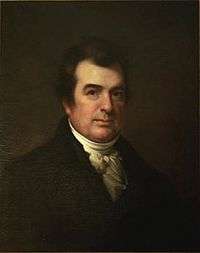 Portrait of Hosack by Rembrandt Peale, 1826 | |
| Born |
August 31, 1769 New York City, Province of New York, British America |
| Died |
December 22, 1835 (aged 66) New York City, US |
| Resting place |
|
| Nationality | American |
| Education | |
| Occupation |
|
| Spouse(s) |
|
| Medical career | |
| Institutions | |
| Signature | |
|
| |
David Hosack FRS FRSE FLS (August 31, 1769 – December 22, 1835) was a noted American physician, botanist, and educator.[2] He remains widely known as the doctor who tended to the fatal injuries of Alexander Hamilton after his duel with Aaron Burr in July 1804, and who had similarly tended to Hamilton's son Philip after his fatal 1801 duel with George Eacker.[3]
Early life and college
Hosack was born in New York City, the first of seven children of Alexander Hossack [sic], a merchant from Elgin in Scotland, and his wife Jane Arden.[4] Following the end of the American Revolutionary War, Hosack was sent to New Jersey academies to further his education, first in Newark and then Hackensack. He would go on to attend Columbia College, now a branch of Columbia University,[2] where he began as a student of art, but eventually became fascinated by medicine.
While at Columbia, he entered into a medical apprenticeship with Dr. Richard Bayley at New York Hospital. While Hosack was studying at the hospital in early 1788, a mob formed outside to protest the illicit obtainment of cadavers from graveyards, which left medical teaching scandalous and disliked. After a medical student taunted the crowd by waving the arm of one of the corpses out of a window at the mob, a riot ensued and Hosack, trying to protect the laboratory, was hit on the head with a heavy stone. Soon afterward, Hosack transferred to Princeton (then known as the College of New Jersey).[2] Hosack graduated from Princeton in 1789.[2]
Medical education and early practice
In 1789, after graduating from Princeton, Hosack enrolled as a medical student under Dr. Nicholas Romayne, where he regularly visited homes for the poor and insane, as they were among the few places to offer clinical instruction. In the fall of 1790, Hosack transferred to a medical school in Pennsylvania, where he wrote a doctoral dissertation on cholera. He married in early 1791, and received his medical degree that spring.
In 1791, Hosack and his wife Catharine moved to Alexandria, Virginia, where he opened his first medical practice. They returned a year later to New York City.
During Hosack's first few years in medical practice, he concluded that the best practitioners had received at least some of their schooling in Europe, and convinced his father to pay his way to Britain in order to obtain such schooling. Upon arriving in the United Kingdom, Hosack matriculated at the University of Edinburgh, where he was reportedly horrified to find his knowledge of botany was sorely lacking. Well received by some of the leading scientific minds of the period, Hosack spent much of his time in their botanical gardens and lecture halls. He ultimately became one of the leading American scholars of botany.
Hosack returned to America by 1796, and established a practice in New York City. A good deal of Hosack's clinical work was as a family practitioner, including pediatric and obstetric care.
In the years that followed, Hosack gained a reputation as a confirmed family man, and for living well. He became a very popular medical practitioner and professor, known as a visionary and a liberal spender willing to sacrifice his wealth to his scholarly interests.
Hamilton-Burr duel
Hosack was the family doctor of Alexander Hamilton and his family, and is perhaps best known as the doctor present during Hamilton's duel with Aaron Burr in Weehawken, New Jersey on July 11, 1804.[3] Hosack, who was a friend to both Hamilton and Burr,[5] treated Hamilton after Burr fired, and accompanied him across the river to the dockside home of William Bayard Jr., where Hamilton died the next day. Hosack had also treated Hamilton's son Philip after he was fatally shot by George Eacker in a duel at the same location in 1801. At Alexander Hamilton's funeral, Hosack was one of the pallbearers.[5]
Three years after the duel, Burr was tried and acquitted on a charge of treason for a conspiracy to form a new nation in the Louisiana Territory and Spanish Texas.[5] Hosack loaned Burr money for passage on a ship to Europe, where Burr lived for several years in self-imposed exile to escape his creditors and the notoriety resulting from the trial.[5]
Contributions to medicine and science
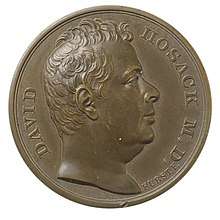
Hosack made many important contributions to the field of medicine in his lifetime. He performed the first successful ligature of an aneurysm of the femoral artery. He was also the first to introduce the operation for hydrocele by injection, was one of the first physicians to use a stethoscope, and was a strong advocate of smallpox vaccination. He also made significant progress towards combating yellow fever, and was the first man to make an accurate description of its symptoms.
Hosack was the creator in 1801 of America's first botanical garden, the Elgin Botanic Garden, which he modeled after gardens he had seen in England.[5]
Teaching career
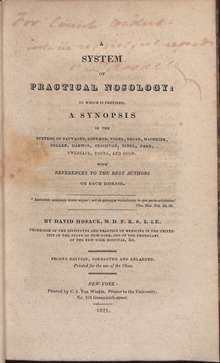
Hosack was appointed professor of natural history at Columbia College in 1795, and in 1797 succeeded to the chair in materia medica.[2] By 1801, he was also a professor of botany.[6]
In 1807, he was named professor of midwifery and surgery in the Columbia University College of Physicians and Surgeons, later holding a chair in Theory and Practice of Medicine, and a chair in Obstetrics and the Diseases of Women and Children. For a time, Hosack also offered a course in training at his own private medical school.[7][8] In 1826, Hosack helped organize the short-lived medical department of Rutgers College, later associated with Geneva Medical College from 1827 to 1830.[9]
One of Hosack's most distinguished students was a celebrated New York City physician, John Franklin Gray, who later became the first practitioner of homeopathy in the United States. Gray's embrace of homeopathy, a pseudoscientific discipline, resulted in the loss of Hosack's friendship.[7][10][11]
Establishment of hospitals and schools
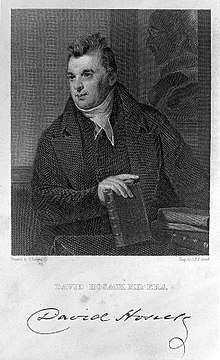
Lying-In Hospital of New York
In 1798, following a yellow fever epidemic, Hosack proposed opening the first lying-in hospital in New York, a maternity clinic where he could offer health care to poor pregnant women.[12] He raised funds from subscribers, including Alexander Hamilton, to purchase a house on Cedar Street where the Lying-In Hospital opened in 1799.[13] In 1801, the Lying-In Hospital moved into space rented from New York Hospital, but ceased operations in 1827 when New York Hospital refused to host the facility any longer.[12][14] The institution continued to exist on paper as a charitable society for several decades after Hosack's death, ultimately merging in 1890 with an obstetrical dispensary that became part of New York Hospital, now NewYork–Presbyterian Hospital.[12][13]
Medical colleges
Hosack and his former teacher, Dr. Nicholas Romayne, both at various times sought academic sponsorship from colleges in order to found new medical schools at those colleges. They were early proponents of the belief that medical education should be easily accessible.[9] One of Hosack's earlier victories was the merger of the College of Physicians and Surgeons and Columbia University.
In 1826, Hosack had a falling out with the College of Physicians and Surgeons at Columbia, and sought another university to host his medical faculty.[9] He successfully pursued an alliance with Rutgers College, bringing his group of colleagues to New Brunswick, New Jersey. Medical instruction at Rutgers began on November 6, 1826; however, as quickly as the medical college came into existence, opposition surfaced from the medical establishment in New York. Hosack and Romayne's "flamboyant personalities and notoriety" attracted students and money to Rutgers from competing schools, drawing animosity from their New York colleagues, and resulting in much political maneuvering among county and state medical societies, medical schools, and the New York legislature.[9]
Hosack came under attack by the County Medical Society of New York for "unjustifiable interference in the medical concerns of the state and disregard for the provisions of the laws of the state regarding medical education."[9] In response to detractors in New York, Rutgers countered with attacks against Columbia's medical college and its supporters for "perpetuating monopoly in medical education."[9] Two years of acrimonious debate ended with Hosack's opponents successfully enacting a law that rendered any medical degree granted outside New York City ineligible for obtaining a license to practice medicine in New York State, effectively ending the medical school in New Brunswick.[9]
After the defeat, Hosack traveled to upstate New York and succeeded in gaining the sponsorship of Geneva College in Geneva, New York.[15] Soon after, the medical school previously established in New Jersey at Rutgers transferred its allegiance to Geneva.[16] The trustees of that college voted on October 30, 1827 to establish the medical faculty.[15] According to the trustees' minutes, Geneva's medical college was to consist of two branches, one in Geneva and the other in New York City. Each branch would have six professors. The branch in Geneva never materialized, due to multiple delays, and the upstate venture was abandoned; however, the branch in New York City opened in early November 1827, "amid a barrage of criticism on the part of the New York College of Physicians and Surgeons."[15]
The Geneva affiliation was also short lived, lasting from 1827 to 1830. The "intrigues and political in-fighting" that had opposed Hosack in his Rutgers endeavor continued, and would ultimately lead to a resolution in the New York Supreme Court.[9] Hosack's adversaries filed suit in The People v. The Trustees of Geneva College, in which the court ruled that the college did not have the power to operate or appoint a faculty at any place but Geneva, invalidating the branch of Geneva College in New York City.[9]
Horticulture and botany
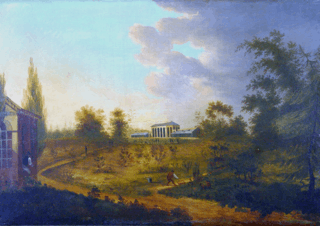
Hosack was the founder and first president of the New York Horticultural Society, the first such organization in America. He brought in English botanist Sir James Edward Smith, as well as John Adams, Thomas Jefferson, James Madison, and the Marquis de Lafayette, naming them honorary members.[17]:174–175
In 1801, Hosack created the Elgin Botanic Garden, named for his father's Scottish birthplace.[5] It was the first public botanical garden in the United States,[18] established with his purchase of twenty acres of rural land on the outskirts of New York City for just under $5,000,[19] equivalent to $91,000 in 2016 dollars.[20] The location, 3½ miles from what was then the city limit, is now bounded by 47th Street on the south, 51st Street on the north, and Fifth Avenue on the east, reaching nearly to Sixth Avenue on the west.[19] It is the present site of Rockefeller Center.[21]
The entire property "was intended by Professor Hosack for a botanical garden, the prime object of which was to be the collection and cultivation of native plants of this country, especially such as possess medicinal properties or are otherwise useful."[6] At his own expense, Hosack landscaped the garden with a variety of indigenous and exotic plants, mostly of American origin. By 1805, after Hosack had spent $75,000 on the effort, the garden was home to 1,500 species of plants from all over the world, including some rare specimens contributed by Thomas Jefferson.[19] The following year, Hosack published a catalogue and visitors' guide, containing an extensive list of the plants under cultivation at Elgin.[6]
Hosack's funds were insufficient to support such a project indefinitely, and it was suggested that he was so preoccupied with his endeavors in the creation of Rutgers Medical College that he had neither time nor money to continue the garden.[6] The State of New York purchased Elgin from Hosack, pursuant to an 1810 act of the New York State Legislature, for a much lower sum than Hosack had paid for the property.[1]:55[19]
Care of the garden was placed in the hands of the Board of Regents of the University of the State of New York, which then gave it to Columbia College in 1814.[6] Columbia had no interest in continuing with the costly project. Elgin Botanic Garden was abandoned and eventually fell into decay, and Columbia ultimately leased the land to John D. Rockefeller, Jr. in the 1920s for the construction of Rockefeller Center.[1]:55
Personal life
Marriages and children
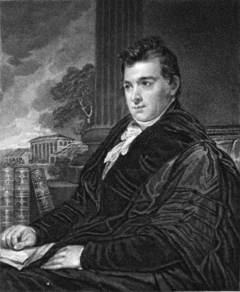
Early in 1791, shortly before receiving his medical degree, Hosack married Catharine Warner, whom he had met while studying at Princeton. Their son Alexander was born in Virginia in June 1792, after which the family moved back to New York City. Shortly after Hosack returned from Scotland to America, his son died. Catharine died soon after, in 1796, giving birth to a second child who also died. These personal tragedies, along with epidemics of yellow fever that hit Philadelphia in 1793 and New York in 1795 and 1798, led Hosack to devote much of his life thereafter towards the expansion of medical knowledge and education, as well as the training of doctors in caring for women and children. Hosack became an advocate for the betterment of lives of the poor, which led him to become a founder of the Humane Society.
Close to two years after his first wife died, Hosack married a Philadelphia woman, Mary Eddy,[2] a sister of Thomas Eddy, a prominent Philadelphia philanthropist and prison reformer.[2] David and Mary Hosack had nine children, seven of whom survived to adulthood. These included Alexander Eddy Hosack (1805–1871), a pioneering surgeon who took on much of his father's practice after his death.[22]
After Mary died in 1824, he married Magdalena Coster, a widow of one of his friends and a mother with seven children of her own. The families were successfully combined, living in a house on Chambers Street, and maintaining a country estate for summer getaways on Kip's Bay—both part of the Coster inheritance.
Social and intellectual pursuits
.jpg)
In the late 1820s and the 1830s, the Hosacks hosted a salon in their home every Saturday, remarkable for the leading artists and intellectuals as well as other medical men who attended, and they became well known as social leaders in the city.[17]:166 Hosack befriended the poet William Cullen Bryant and was a patron of American artists including Samuel F. B. Morse, the inventor of telegraphy, and Thomas Cole.
Hosack was one of the founders of the New-York Historical Society, and its fourth president (1820–1827). He was also a president of the Literary and Philosophical Society of New York. He was elected a member of the American Antiquarian Society in 1814,[23] and a Fellow of the American Academy of Arts and Sciences the following year.[24] In 1821, he was elected a foreign member of the Royal Swedish Academy of Sciences, and in 1827 he was elected into the National Academy of Design as an Honorary Academician.
In later life, with his third wife's family assets to assist in his enterprises, David Hosack was able to purchase a Hudson River estate in Hyde Park, New York, former home of his old teacher and sometime partner in medical practice Dr. Samuel Bard, and he recommenced developing a fine botanical garden. The Hosacks' opulent retreat became a popular haunt of visitors who enjoyed the mystique of the Hudson River valley, including not only painters and naturalists but the writer Washington Irving.
Final days
The Great Fire of New York, which began on December 15, 1835, destroyed between 530 and 700 buildings in New York City, covering 13 acres (53,000 m2) in 17 city blocks.[25] Hosack's personal loss of property in the fire was valued at $300,000,[18] equivalent to $7,600,000 in 2016 dollars.[20]
Hosack died of a stroke one week afterward, on December 22, 1835, and was buried at New York Marble Cemetery.[1]:57 In 1888, Hosack's descendants had him reinterred at Trinity Church Cemetery, where Alexander Hamilton is also buried.[1]:57
In popular culture
- Gillen D'Arcy Wood's 2005 historical novel, Hosack's Folly, was based on the life of Dr. Hosack. Hosack's Folly takes place twenty years after the Hamilton-Burr duel, during a time of great danger in New York due to a yellow fever epidemic.[7]
- In the 2015 Broadway musical Hamilton, an ensemble member carrying a medical bag represents Hosack (not identified by name) at the duel in which Alexander Hamilton is killed.[26] Aaron Burr, in the song "The World Was Wide Enough", sings that Hamilton brought "a doctor that he knew," adding that "the doctor turned around so he could have deniability."[26][27]
Selected works
- An introductory lecture on medical education (1801)
- Observations on the Canada thistle (1810)
- Observations on the establishment of the College of Physicians and Surgeons in the city of New-York (1811)
- Observations on the surgery of the ancients: vindicating their claims to many of the reputed discoveries and improvements of modern times (1813)
- Observations on the advantages of exposing wounds to the air after capital operations (1813)
- Observations on vision (1813)
- Observations on the laws governing the communication of contagious diseases: and the means of arresting their progress (1815)
- Tribute to the memory of the late Caspar Wistar (1818)
- System of practical nosology (1821)
Further reading
- Hosack, Alexander Eddy (1861). A memoir of the late David Hosack, M.D. Philadelphia: Lindsay & Blakiston.
- Johnson, Victoria (2018). David Hosack, Botany, and Medicine in the Garden of the Early Republic. Liveright. ISBN 9781631494192.
- McDowell, Marta (June 25, 2018). "Deep Below Rockefeller Center Lies a Legendary Botanical Garden". The New York Times.
References
- 1 2 3 4 5 Jeffe, Elizabeth Rohn (Spring 2004). "Hamilton's Physician: David Hosack, Renaissance Man of Early New York" (PDF). New-York Journal of American History (3): 54–58.
- 1 2 3 4 5 6 7 Princeton University Library (2002). "David Hosack Collection, 1793–1916 (bulk 1818–1850): Finding Aid". Princeton University Manuscripts Division. Archived from the original on 2012-08-06. Retrieved June 16, 2010.
- 1 2 "Dr. David Hosack, MD, and Rutgers - The politics of medical education in the nineteenth century" (PDF). New Jersey Medicine, 2002. Retrieved June 8, 2010.
- ↑ Biographical Index of Former Fellows of the Royal Society of Edinburgh 1783–2002 (PDF). The Royal Society of Edinburgh. July 2006. ISBN 0 902 198 84 X.
- 1 2 3 4 5 6 Leitch, Alexander (1978). A Princeton Companion. Princeton University Press. pp. 261–262.
- 1 2 3 4 5 Wilbert, M.I. (September 1908). "Some Early Botanical and Herb Gardens". American Journal of Pharmacy. Philadelphia College of Pharmacy and Science. 80: 423. Retrieved June 16, 2010.
- 1 2 3 Hoge, Robert Wilson (Spring 2007). "A Doctor for All Seasons: David Hosack of New York". ANS Magazine. American Numismatic Society. 6 (1). Archived from the original on 2011-07-13. Retrieved July 1, 2006.
- ↑ Hosack, David (1816) [1812–13]. Course of studies designed for the private medical school established in New-York. New York: Van Winkle, Wiley & Co.
- 1 2 3 4 5 6 7 8 9 "Inventory to the Records of the Rutgers Medical College (New York, N.Y.), 1792-1793". Special Collections and University Archives, Rutgers University Libraries. Retrieved June 4, 2010.
- ↑ King, William Harvey, ed. (1905). History of Homoeopathy and Its Institutions in America, Vol. I. New York: Lewis Publishing Company. pp. 79–82, 94–95, 200–201.
- ↑ Shira, Donald D., ed. (July 1940). "Ohio Medical History of the Period, 1835–1858". Ohio Archaeological and Historical Quarterly. Ohio History Journal. 49 (3): 338. Archived from the original on 2017-10-11. Retrieved July 1, 2009.
- 1 2 3 Epstein, Randi Hutter (2010). Get Me Out: A History of Childbirth from the Garden of Eden to the Sperm Bank. W. W. Norton & Company. pp. 66–67. ISBN 9780393064582.
- 1 2 Engle Jr., Ralph. "Lying-In Hospital". Weill Cornell Medicine. Archived from the original on 2017-06-25.
- ↑ "Book Notices: The Story of the Lying-in Hospital of the City of New York". JAMA. 111 (27): 2512–2513. December 31, 1938. doi:10.1001/jama.1938.02790530066028.
- 1 2 3 The Pioneer Days. Syracuse University, Syracuse, N.Y., 1952. Retrieved June 5, 2010.
- ↑ History of the College of Physicians and Surgeons in the City of New York. Medical Department of Columbia College, 1888. 1888. Retrieved June 5, 2010.
- 1 2 Robbins, Christine Chapman (1964). David Hosack: Citizen of New York. American Philosophical Society. pp. 174–175.
- 1 2 Bolton, H.C. (October 1897). "Early American Chemical Societies". Appletons' Popular Science Monthly. New York: D. Appleton and Co. 51: 822. Retrieved June 8, 2010.
Hosack ... was Professor of Botany and Materia Medica in Columbia College, but is best known as the founder of the first public botanic garden in the United States in 1801. He died under tragic circumstances—of shock at the disastrous conflagration in New York city which swept away his property to the value of $300,000.
- 1 2 3 4 Okrent, Daniel (2004). Great Fortune: The Epic of Rockefeller Center. Penguin Books. pp. 20–22. ISBN 9781101666906.
- 1 2 Thomas, Ryland; Williamson, Samuel H. (2018). "What Was the U.S. GDP Then?". MeasuringWorth. Retrieved January 5, 2018. United States Gross Domestic Product deflator figures follow the Measuring Worth series.
- ↑ Dana Schulz (March 30, 2016). "The Country's First Botanic Garden Was on 20 Wooded Acres at Today's Rockefeller Center". 6sqft. Retrieved September 1, 2016.
- ↑ Butler, Samuel Worcester, ed. (March 25, 1871). "News and Miscellany: Obituaries". Medical and Surgical Reporter. 24 (734).
- ↑ American Antiquarian Society Members Directory
- ↑ "Book of Members, 1780–2010: Chapter H" (PDF). American Academy of Arts and Sciences. Retrieved September 8, 2016.
- ↑ Lamb, Martha Joanna (1896). History of the City of New York: Its Origin, Rise and Progress, Volume 3. New York: A. S. Barnes. p. 726.
- 1 2 Ogasawara, Rie (December 12, 2016). "'Hamilton': Through The Eyes Of Minor Characters". Odyssey. Odyssey Media Group. Archived from the original on 2017-10-12.
- ↑ Miranda, Lin-Manuel; McCarter, Jeremy (2016). Hamilton: The Revolution. Grand Central Publishing. p. 272. ISBN 978-1-4555-6753-9.